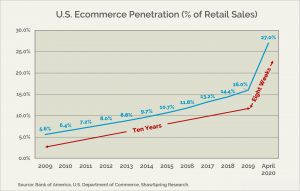There is no shortage of eyebrow-raising statistics documenting the widespread economic disruption that has befallen the US since March. Among them, Census Bureau reports of a historic 16.4 percent drop in retail sales in April, including an 89 percent year-over-year decrease for clothing and accessories stores. Adobe Analytics estimates an 87 percent year-over-year increase in curbside pickup sales for the month of March. Neiman Marcus, J Crew and Pier 1 are among the most prominent retailers to file for bankruptcy protection.
No statistic better encapsulates the sudden change than the U.S. Department of Commerce study that shows ecommerce penetration as a percentage of retail sales increasing more in March and April than the previous 10 years. From 2009 until the end of February, ecommerce penetration increased from 5.6 to 16 percent. In March and April, it rose to 27 percent.

This is what is meant by digital transformation acceleration. It is a new reality marked by unprecedented, wholesale changes to consumer behaviors. To succeed in this new reality brands must connect with customers across all digital channels with relevant engagements that are in the context of a unique customer journey.
Tame Disruption with Data Management
Rising to the challenge requires more than a mere recognition that buying patterns have become more unpredictable than ever. The new reality demands more from a brand than delivering a blanket message to customers that it acknowledges the disruption.
Rather, taming digital disruption requires advanced enterprise data management capabilities. Brands that succeed in the new digital-first environment will be the ones that have a handle on all of their data, as well as an understanding of how to bring the data together, secure it, and monetize it. Data security, usability, manageability and performance become even more important when data is rightly regarded as the currency that unlocks relevant, timely and personalized customer experiences throughout an omnichannel customer journey.
A timely real-world example of the importance of data management is the large increase in curbside pickup service, which accounts for a sizeable percentage of surging ecommerce sales. Data privacy is just one of seemingly countless data management tasks that must be accounted for to deliver a seamless, personalized experience at scale. Adherence to GDPR, CCPA and other data privacy regulations add layers of complexity to ensure that a seamless, personalized curbside pickup experience is tailored to each customer’s preferences for how their data is collected, stored and used.
Data Management and Curbside: a Winning Match
A digital customer experience hub with a master data management component that eliminates the lag time between data ingestion, processing and calculation updates is another requirement in delivering a superior curbside pickup experience that delights a customer with relevance. Pushing data aggregates out to subscribers in real time ensures that every engagement channel and external system that subscribes to the updates is synchronized with a customer’s unique journey. With curbside pickup, this capability has direct implications for inventory, online and in-store communications, notifications, and offers, to name a few – all of which require real-time interactions to keep pace with the customer. Conversely, a platform that ingests data and calculates aggregates for a nightly batch upload to an FTP site that is later picked up by a subscriber via web services or API integrations will likely introduce friction into any curbside pickup service, either by failing to deliver relevance or failing to have the right product ready at the right time.
A new reality marked by digital transformation acceleration will produce winners and losers in the battle to provide customers with a personalized customer experience that was in great demand even before the sudden disruption. Having your data in order is an all-important first step in meeting this expectation. Anyone can acknowledge the disruption. Showing true empathy for your customers, however, requires an understanding that a personalized, relevant and increasingly digital experience is only made possible when you can trust that your customer data is in the right place.
RELATED CONTENT
Now is the Time to Set Ambitious Marketing Goals
Retailers Will Adapt of Die in the New Reality
A Contextual Customer Relationship is the Basis for a Superior Experience
